Dinámica del dinero y los precios bajo el patrón oro en la teoría neoclásica del crecimiento
DOI:
https://doi.org/10.17533/udea.le.n90a02Palabras clave:
Patrón oro, modelo de crecimiento, acumulación de riqueza, inflaciónResumen
El propósito de este estudio es determinar la dinámica del dinero y los precios bajo el patrón oro en un modelo de crecimiento neoclásico de un sector. Para esto, se construye un modelo utilizando algunas aproximaciones de la literatura sobre la teoría de la dinámica económica. En particular, el sector productivo se basa en el modelo de Solow, el patrón oro y la dinámica de los precios está fundamentada en Barro (1979) y la demanda de dinero está influenciada por el marco tradicional con dinero en la función de utilidad. El modelo integra las ideas de estas aproximaciones dentro de una estructura compacta. A través de simulaciones, se muestra que el sistema económico se caracteriza por un estado estacionario único e inestable. También se llevan a cabo análisis de dinámica comparativa respecto a cambios en algunos parámetros.
Descargas
Citas
Azariadis, Costas (1993). Intertemporal Macroeconomics. Oxford: Blackwell.
Barro, Robert J. (1979). “Money and the Price Level under the Gold Standard”, Economic Journal, Vol. 89, No. 353, pp. 13-33.
Barro, Robert J. & Sala-i-Martin, Xavier (1995). Economic Growth. New York: McGraw-Hill Inc.
Bohanon, Cecil E.; Lynch, Gerald J. & van Cott, T. Norman (1985). “A Supply and Demand Exposition of the Operation of a Gold Standard in a Closed Economy”, Journal of Economic Education, Vol. 16, No. 1, pp. 16-26.
Bordo, Michael David & Ellson, Richard Wayne (1985). “A Model of the Classical Gold Standard with Depletion”, Journal of Monetary Economic, Vol. 16, No. 1, pp. 109-120.
Burmeister, Edward & Dobell, Rodney (1995). Mathematical Theories of Economic Growth. London: MacMillan.
Cagan, Phillip (1956). “The Monetary Dynamics of Hyperinflation”. In Friedman, M. (Ed.), Studies in the Quantity Theory of Money (pp. 25-117). Chicago: University of Chicago Press.
Chappell, David & Dowd, Kevin (1997). “A Simple Model of the Gold Standard”, Journal of Money, Credit and Banking, Vol. 29. No. 1, pp. 94-105.
Dempster N. (2009, July). “Gold as a Tactical Inflation Hedge and Long-term Strategic Asset”, World Gold Council. Retrieved from: http://www.gold.org/download/rs_archive/AssetAllocation_Inflation_July09.pdf.
Dowd, Kevis & Sampson, Anthony A. (1993). “A New Model of the Gold Standard”, The Canadian Journal of Economics, Vol. 26, No. 2, pp. 380-391.
Dubey, Pradeep; Geanakoplos, John & Shubik, Martin (2003). “Is Gold an Efficient Store of Value”, Economic Theory, Vol. 21, No. 4, pp. 767-782.
Goldman, Steven M. (1972). “Hyperinflation and the Rate of Growth in the Money Supply”, Journal of Economic Theory, Vol. 5, No. 2, pp. 250-257.
Keynes, John Maynard et al. (1943). “Proposals by British Experts for an International Clearing Union”, In Proceedings and Documents of the United Nations Monetary and Financial Conference vol. 2. Washington: U.S. Government Printing Office, 1948.
Lehrman, Lewis (1981, 30 July). The Case for a Gold Standard. Wall Street Journal.
Mundell, R. A. (1968). International Economics. New York: Macmillan.
Patinkin, Don (1965). Money, Interest, and Prices: An Integration of Monetary and Value Theory (2nd Ed.). New York: Harper & Row.
Ranson, David (2005). “Inflation Protection: Why Gold Works Better Than Other Linkers”, World Gold Council. Retrieved from: http://www.gold.org/download/rs_archive/inflation_linkers.pdf.
Ricardo, David (1911). The Principles of Political Economy and Taxation. London: J. M. Dent & Sons. (Original work published 1821).
Sargent, Thomas J. & Wallace, Neil (1973). “The Stability of Models of Money and Growth with Perfect Foresight”, Econometrica, Vol. 41, No. 6, pp. 1043-1048.
Seemuang, Ananya & Rompreert, Suppanunta (2013). “Gold Value Movement and Macroeconomics”, Journal of Business and Economics, Vol. 4, No. 8, pp. 752-60.
Sidrauski, Miguel (1967). “Rational Choice and Patterns of Growth in a Monetary Economy”, American Economic Review, Vol. 57, No. 2, pp. 534-544.
Solow, Robert (1956). “A Contribution to the Theory of Growth”, The Quarterly Journal of Economics, Vol. 70, No. 1, pp. 65-94.
Thomas, H. (2015, 5 june). Don’t Expect Peak Gold Prospects to Mean New Price Heights. Wall Street Journal.
Tobin, James (1965). “Money and Economic Growth”, Econometrica, Vol. 33, No. 4, pp. 671-684.
Triffin, Robert (1960). Gold and the Dollar Crisis. New Haven: Yale University Press.
Wanniski, Jude (1981, 7 December). Supply-Side Case for a Gold Standard. Business Week.
Zhang, Wei-Bin (1993). “Woman’s Labor Participation and Economic Growth - Creativity, Knowledge Utilization and Family Preference”, Economics Letters, Vol. 42, No. 1, pp. 105-110.
Zhang, Wei-Bin (2005). Economic Growth Theory. Hampshire: Ashgate.
Zhang, Wei-Bin (2006). Growth with Income and Wealth Distribution. London: Macmillan.
Zhang, Wei-Bin (2009). “A Small Open Interregional Monetary Economic Growth with the MIU Approach”, Annals of the Alexandru Ioan Cuza University of Iasi, Vol. 56, pp. 210-234.
Descargas
Publicado
Cómo citar
Número
Sección
Licencia
Derechos de autor 2018 Wei-Bin Zhang

Esta obra está bajo una licencia internacional Creative Commons Atribución-NoComercial-CompartirIgual 4.0.
Este sitio web, por Universidad de Antioquia, está licenciado bajo una Creative Commons Attribution License.
Los autores que publiquen en esta revista aceptan que conservan los derechos de autor y ceden a la revista el derecho de la primera publicación, con el trabajo registrado con una Licencia de Atribución-NoComercial-CompartirIgual de Creative Commons, que permite a terceros utilizar lo publicado siempre que mencionen su autoría y a la publicación original en esta revista.
Los autores pueden realizar acuerdos contractuales independientes y adicionales para la distribución no exclusiva de la versión del trabajo publicada en la revista (por ejemplo, incluirla en un repositorio institucional o publicarla en un libro) siempre que sea con fines no comerciales y se reconozca de manera clara y explícita que el artículo ha sido originalmente publicado en esta revista.
Se permite y recomienda a los autores publicar sus artículos en Internet (por ejemplo, en páginas institucionales o personales), ya que puede conducir a intercambios provechosos y a una mayor difusión y citación de los trabajos publicados.












 , respectively, stand for the inflation rate and the per capita (physical) wealth. We have
, respectively, stand for the inflation rate and the per capita (physical) wealth. We have
 stand for the amount of gold owned by the representative household. Current income per capita is given by
stand for the amount of gold owned by the representative household. Current income per capita is given by
 is the interest payment,
is the interest payment,  is the rent revenue from owning gold, w is the wage payment, and (m is the cost of holding money. Let a(t) stand for the total value of assets that the representative household owns. We have
is the rent revenue from owning gold, w is the wage payment, and (m is the cost of holding money. Let a(t) stand for the total value of assets that the representative household owns. We have

 saving, s(t) and consumption of goods, c(t). The budget constraint is given by
saving, s(t) and consumption of goods, c(t). The budget constraint is given by


 .The consumer’s utility function is specified as follows:
.The consumer’s utility function is specified as follows:










 and
and  are functions of
are functions of 
 and
and  .
. 
 and
and  by the following procedure:
by the following procedure:  and
and  by (A2) →
by (A2) →  by (A7) →
by (A7) →  by (A14) →
by (A14) →  by (A12) →
by (A12) →  by (A10) →
by (A10) →  by (A5) →
by (A5) →  ,
, and
and  by (13) →
by (13) →  by (19) →
by (19) →  by (1) →
by (1) → 
 →
→  →
→  by (A3).
by (A3).
 and
and  As shown in the Appendix, the expressions are complicated, so it is difficult to explicitly derive economic implications from the three equations. For illustration, we simulate the model to illustrate the behavior of the system. In the remainder of this study, we specify the parameters in
As shown in the Appendix, the expressions are complicated, so it is difficult to explicitly derive economic implications from the three equations. For illustration, we simulate the model to illustrate the behavior of the system. In the remainder of this study, we specify the parameters in 
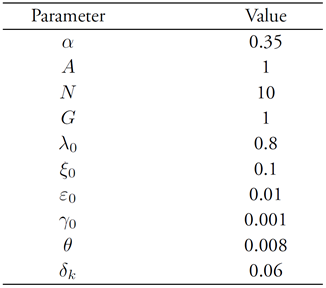


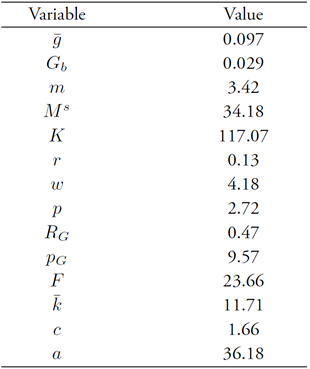
 stand for the percentage rate of change of the variable
stand for the percentage rate of change of the variable  due to changes in the parameter value.
due to changes in the parameter value.  This implies that the money stock is reduced for a fixed amount of gold backing. The simulation results are plotted in
This implies that the money stock is reduced for a fixed amount of gold backing. The simulation results are plotted in 
 The simulation results are plotted in
The simulation results are plotted in 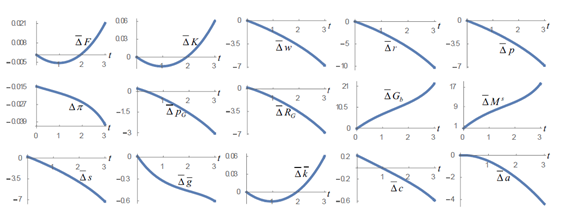
 The simulation results are plotted in
The simulation results are plotted in 

 The simulation results are plotted in
The simulation results are plotted in  . The simulation results are plotted in
. The simulation results are plotted in 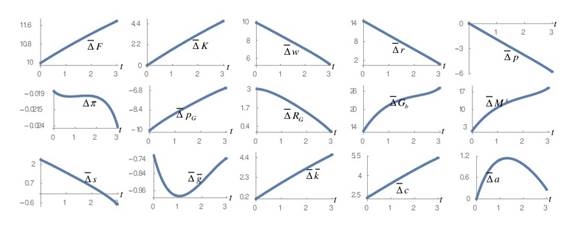
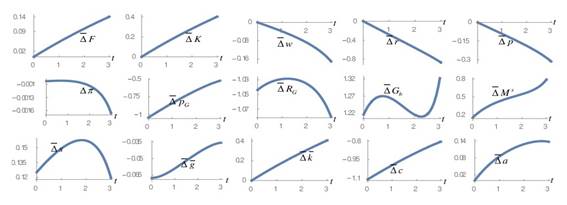
 .The simulation results are plotted in
.The simulation results are plotted in 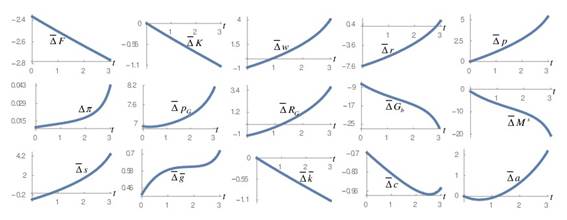



























 and
and  The following procedure shows how to express all the other variables as functions of
The following procedure shows how to express all the other variables as functions of 
 and
and  by (A1) →
by (A1) →  and
and  by (A2) →
by (A2) →  by (A7) →
by (A7) →  by (A14) →
by (A14) →  by (A12) →
by (A12) →  by (A10) →
by (A10) →  by (A5) →
by (A5) → 
 and
and  by (13) →
by (13) →  by (19) → /by (1) →
by (19) → /by (1) →  →
→  →
→  by (A3).
by (A3).